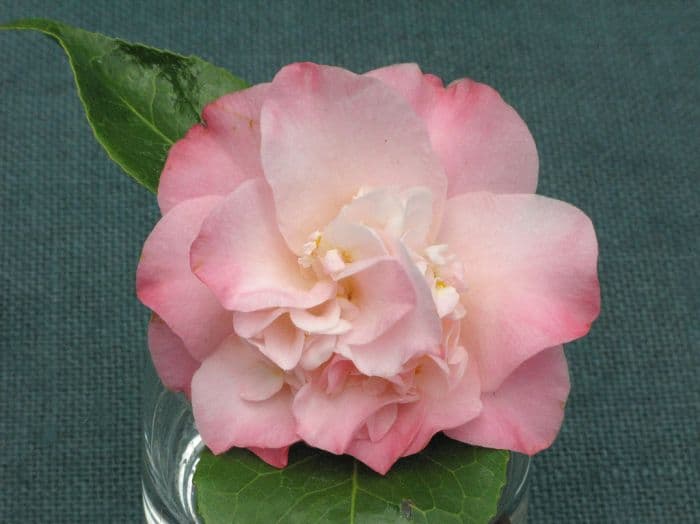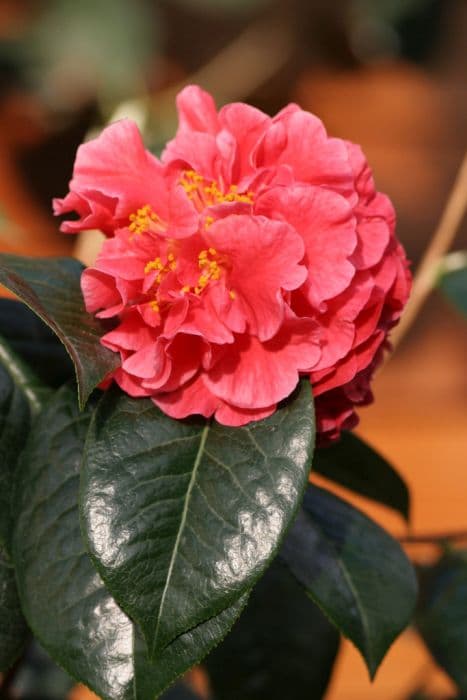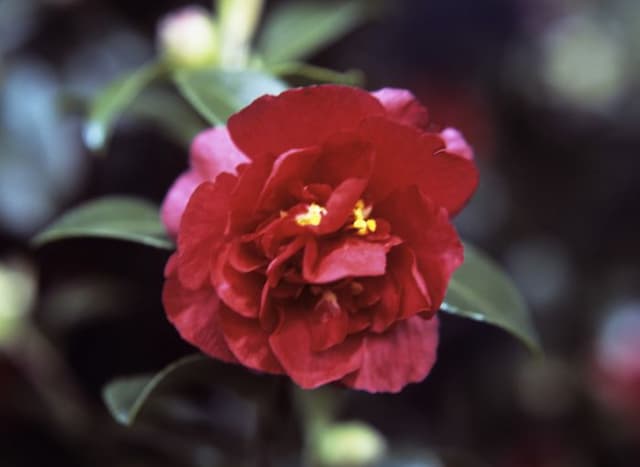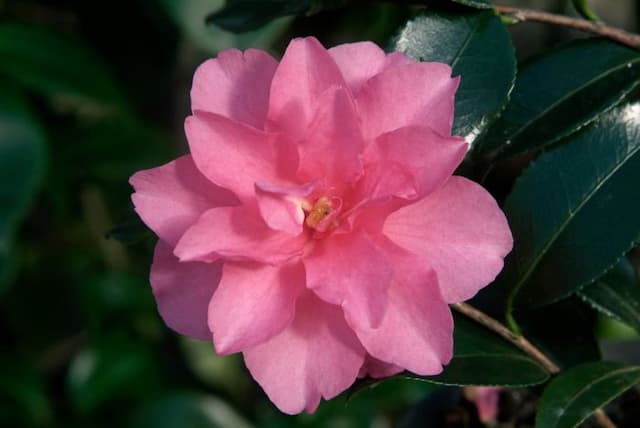Japanese Camellia Camellia japonica 'Ballet Dancer'

ABOUT
Camellia japonica 'Ballet Dancer' is popularly known for its enchanting flowers and lush, glossy foliage. This particular variety is distinctive for its alluring blooms which exhibit a peony-like form. The flowers are large and ruffled, combining shades of soft pink to creamy white with a hint of deeper pink streaks, creating a delightful dance of color reminiscent of a ballerina's tutu. Each flower is composed of multiple layers of delicate petals, arranged in a somewhat loose, yet graceful fashion, giving an impression of movement and elegance. The overall effect is one of soft, fluffy fullness that stands out against the robust backdrop of the plant's evergreen leaves. The deep green leaves present a shining surface, and they are typically quite broad and oval-shaped, with a subtly serrated edge. This dense greenery provides year-round interest and an excellent contrast to the dainty, opulent flowers, which emerge in the cooler months, bringing a splash of color to the garden when many other plants are not in bloom. The appearance of the Camellia japonica 'Ballet Dancer' is a combination of its spectacular, showy flowers and its rich, green leaves which together create an aesthetic of both sophistication and natural beauty, evoking the image of a poised and elegant ballet dancer in full costume.
About this plant
 Names
NamesFamily
Theaceae
Synonyms
Japanese Camellia, Rose of Japan, Common Camellia
Common names
Camellia japonica 'Ballet Dancer'
 Toxicity
ToxicityTo humans
Camellia is generally considered non-toxic to humans. However, as with many plants, individual sensitivities can vary, and some people might experience mild irritation or an allergic reaction when handling the plant or ingesting it in large quantities. It is always best to avoid consumption of plant parts that are not typically considered food items.
To pets
Camellia is also generally considered non-toxic to pets. However, individual animals may react differently, and ingestion of plant parts may cause mild gastrointestinal upset in some pets. It's a good practice to monitor your pet and to keep houseplants out of their reach if they are known to chew on plants. If your pet were to ingest a significant amount of Camellia, observing your pet for any signs of distress and consulting with a veterinarian would be advisable.
 Characteristics
CharacteristicsLife cycle
Perennials
Foliage type
Evergreen
Color of leaves
Green
Flower color
Pink
Height
6-10 feet (1.8-3 meters)
Spread
5-7 feet (1.5-2.1 meters)
Plant type
Shrub
Hardiness zones
7
Native area
Japan
Benefits
 General Benefits
General Benefits- Aesthetic Appeal: The Camellia japonica 'Ballet Dancer' adds visual interest to gardens with its delicate, ruffled double flowers that are often a soft pink in color.
- Year-Round Foliage: This variety of Camellia retains its glossy, deep green leaves throughout the year, maintaining a lush appearance even when not in bloom.
- Low Maintenance: Once established, Camellias are relatively easy to care for and require minimal pruning and attention.
- Shade Tolerance: Perfect for shaded areas where other plants might struggle, they thrive in dappled sunlight or part shade.
- Privacy and Screening: Camellias can be planted in rows to create natural privacy screens due to their dense foliage and growth habit.
- Habitat for Wildlife: The flowers provide nectar and pollen for bees and other pollinators, while the dense foliage offers shelter for birds.
- Long Blooming Season: Camellias have a protracted flowering period, often from late winter through spring, providing color during times when other plants are dormant.
- Versatility in Landscaping: Ideal for use in a variety of garden styles including formal, woodland, and Japanese-inspired gardens.
- Resilience to Pests: They are relatively resistant to many common garden pests, reducing the need for chemical treatments.
 Medical Properties
Medical PropertiesThis plant is not used for medical purposes.
 Air-purifying Qualities
Air-purifying QualitiesThis plant is not specifically known for air purifying qualities.
 Other Uses
Other Uses- Camellia japonica petals can be used in crafting as natural dye for fabrics, imparting subtle pinks and creams depending on the mordant and fabric used.
- The leaves of the Camellia are suitable for creating high-quality, glossy green mulch that can help retain soil moisture and add aesthetic appeal to garden beds.
- Dried and pressed Camellia flowers make unique bookmarks, adding a touch of nature to personal libraries and gifts.
- Camellia blooms are often used in corsages and boutonnieres for special events like weddings and proms due to their vibrant colors and large, impressive flowers.
- The sturdy stems of Camellia can be used in fine woodworking to create decorative inlays or small accent pieces.
- Camellia petals serve as a colorful garnish for salads and desserts, offering an edible floral touch to culinary presentations.
- When decomposed, Camellia leaves produce an acidic compost that can be used to lower the pH of garden soils for acid-loving plants.
- The plant's dense foliage can act as a natural privacy screen in gardens, creating intimate spaces or obscuring unsightly views.
- Camellia wood, being both hard and smooth, is occasionally carved into handles for small tools or utensils, like letter openers or fine spoons.
- Due to their beauty, individual Camellia blossoms are used in floral photography and art, capturing the intricate details of petals and providing a natural study subject for artists.
Interesting Facts
 Feng Shui
Feng ShuiCamellia is associated with positive energy and refinement in Feng Shui, and it can be used to attract good luck and admiration. As an evergreen with beautiful flowers, it symbolizes enduring and faithful love. Therefore, placing Camellia in the relationship area of your home or garden (which is the southwest corner according to the Bagua map) can help enhance romantic relationships and bring a sense of calm and loyalty to your living space.
 Zodiac Sign Compitability
Zodiac Sign CompitabilityCamellia is not used in astrology practice.
 Plant Symbolism
Plant Symbolism- Adoration: Often given as a gift to show adoration towards someone, the ‘Ballet Dancer’ camellia is a symbol of genuine fondness and deep affection.
- Perfection: With its delicate, perfectly formed petals, it represents the idea of perfection and the striving for excellence.
- Longevity and Faithful Love: As camellias are long-lived and evergreen, they are often associated with enduring and steadfast love.
- Refinement: The camellia is frequently associated with refined beauty and cultivated elegance, mirrored in the 'Ballet Dancer's' graceful form.
- Desire: The lush and vibrantly colored petals can signify a deep desire or yearning, often in a romantic context.
 Water
WaterThe common camellia should be watered thoroughly once the top inch of soil feels dry to the touch. This typically translates to about 1 to 1.5 inches of water per week, depending on the weather and soil conditions. It's important to avoid overhead watering to prevent leaf diseases; instead, water directly at the base of the plant. During the growing season, ensure consistent moisture, especially for potted camellias, which may require more frequent watering. Reduce watering in the fall to prepare the plant for winter, and always adjust based on rainfall to avoid overwatering.
 Light
LightCamellias prefer bright, indirect light or partial shade with protection from harsh afternoon sun. A north or east-facing spot that receives gentle morning light and dappled shade in the afternoon is ideal for the common camellia. Too much direct sunlight can lead to leaf scorch, while too little light can result in fewer flowers.
 Temperature
TemperatureThe common camellia thrives in temperatures ranging from 60 to 80°F but can tolerate minimum winter temperatures of around 20 to 30°F. They are less tolerant of high temperatures above 85°F, which may cause the plant stress. The ideal temperature for vigorous growth and flowering is between 65 and 75°F.
 Pruning
PruningPrune the common camellia to maintain shape and promote healthy growth, ideally just after the blooms fade in late winter or early spring. Remove any dead or damaged branches, thin out dense areas to improve air circulation, and cut back any leggy growth to encourage bushier plants. Pruning at the correct time minimizes the loss of next year's blooms.
 Cleaning
CleaningAs needed
 Soil
SoilJapanese Camellia 'Ballet Dancer' thrives in well-draining, acidic soil with a pH between 5.5 and 6.5. A mix of 1/3 pine bark, 1/3 garden soil, and 1/3 peat moss works well to maintain acidity and provide proper drainage.
 Repotting
RepottingJapanese Camellia 'Ballet Dancer' should generally be repotted every 2-3 years, best done in the late winter or early spring before the growing season starts.
 Humidity & Misting
Humidity & MistingJapanese Camellia 'Ballet Dancer' prefers a humidity level between 40-50%. Consistently high humidity is beneficial for the plant's growth and flowering.
 Suitable locations
Suitable locationsIndoor
Provide bright, indirect light and maintain high humidity for indoor camellias.
Outdoor
Plant in partial shade with acidic soil and shelter from harsh elements.
Hardiness zone
7-9 USDA
 Life cycle
Life cycleCamellia japonica 'Ballet Dancer', commonly known as Japanese camellia, begins its life cycle with seed germination occurring typically in a moist, shaded environment. From the germinating seed, a seedling emerges and establishes itself, eventually growing into a young plant with foliage and a developing root system. As the plant matures, it develops woody stems and a more extensive root system, along with the distinctive glossy, evergreen leaves. On reaching maturity, which can take several years, 'Ballet Dancer' produces large, ornate pink flowers, typically in late winter to early spring, that attract pollinators for sexual reproduction. After pollination, the flowers develop into seed pods, which eventually release seeds to start the cycle anew. Throughout its life, the plant will undergo periodic stages of vegetative growth and dormancy, responding to seasonal changes in temperature and daylight.
 Propogation
PropogationPropogation time
Spring-Early Summer
The Camellia japonica 'Ballet Dancer', commonly known as the Japanese camellia, is most effectively propagated through semi-hardwood cuttings. This is a process typically done in late summer or early fall, after the new growth has matured and begun to harden. To propagate, a cutting of about 4 to 6 inches (10 to 15 centimeters) long is taken with several leaves attached. The lower leaves are removed, and the cut end is often dipped in a rooting hormone to encourage root development. The cutting is then placed in a well-draining medium like a mix of peat and perlite, kept humid, and out of direct sunlight. Rooting can take a few months, after which the new camellia plant can be transplanted into a larger pot or directly into the garden.









